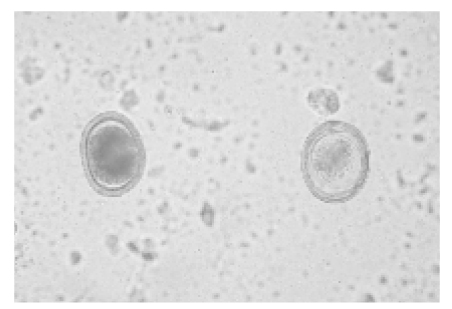J Korean Med Assoc.
2004 Jun;47(6):527-534. 10.5124/jkma.2004.47.6.527.
Parasitic Zoonosis Transmitted by Pet Animals
- Affiliations
-
- 1Department of Parasitology, Chonnam National University, College of Veterinary Medicine, Korea. sungshik@jnu.ac.kr
- KMID: 2065236
- DOI: http://doi.org/10.5124/jkma.2004.47.6.527
Abstract
- The growing popularity of dogs and cats as pet animals in Korea, together with high rates of ascarid and hookworm infections among these animals, has resulted in widespread contamination of the soil with infective eggs and larvae in playgrounds and school yards. Several reports indicated that the prevalence of parasites in soil from playgrounds of kindergarten, elementary schools and residential areas in both urban and rural areas of Korea was as high as 33.3%. With several cases of ocular toxocariasis among Koreans being reported, larva migrans of young people caused by pet animal parasites should be recognized. Although rabies is by far the most dangerous zoonotic pathogen from dogs, children are more cornmonly exposed to various zoonotic parasites such as roundworms, hookworms or giardia originated from pet animals. Several parasites of dogs and cats that can be transmitted to pet owners are discussed.
Keyword
MeSH Terms
Figure
Cited by 2 articles
-
Parasitic Diseases of Companion Animals
Sung Shik Shin
Hanyang Med Rev. 2010;30(3):246-264. doi: 10.7599/hmr.2010.30.3.246.A Survey of Intestinal Parasite Infection during a 10-Year Period (2003-2012)
Young-Eun Kim, Hee Jae Huh, Yu-Yean Hwang, Nam Yong Lee
Ann Clin Microbiol. 2013;16(3):134-139. doi: 10.5145/ACM.2013.16.3.134.
Reference
-
5. Barriga OO. A critical look at the importance, prevalence and control of toxocariasis and the possibilities of immunological control. Vet Parasitol. 1988. 29:195–234.
Article7. Soulsby EJL. Helminths, arthropods and protozoa of domesticated animals. 1982. 7th ed. Philadelphia: Lea & Febiger;150–155.8. Park SP, Park I, Park HY, Lee SU, Huh S, Magnaval JF. Five cases of ocular toxocariasis confirmed by serology. Korean J Parasitol. 2000. 38:267–273.
Article9. Moreira-Silva SF, Rodrigues MG, Pimenta JL, Gomes CP, Freire LH, Pereira FE. Toxocariasis of the central nervous system : with report of two cases. Rev Soc Bras Med Trop. 2004. 37:169–174.10. Bächli H, Minet JC, Gratzl O. Cerebral toxocariasis: a possible cause of epileptic seizure in children. Childs Nerv Syst. 2004. 05. 12. (Epub ahead of print).
Article11. Sorvillo F, Ash LR, Berlin OGW, Yatabe J, Degiorgio C, Morse SA. Baylisascaris procyonis: An emerging helminthic zoonosis. Emerging Infectious Diseases. 2002. 8:355–359.12. Monis PT, Thompson RC. Cryptosporidium and Giardiazoonoses: fact or fiction? Infect Genet Evol. 2003. 3:233–244.
Article13. Majewska AC. Successful experimental infections of a human volunteer and Mongolian gerbils with Giardia of animal origin. Trans R Soc Trop Med Hyg. 1994. 88:360–362.
Article14. Fain A. Epidemiological problems of scabies. Int J Dermatol. 1978. 17:20–30.
Article15. Maunsell K, Wraith DG, Cunnington AM. Mites and housedust allergy in bronchial asthma. Lancet. 1968. 15:1267–1270.
Article16. Smith EB, Claypoole TF. Canine scabies in dogs and in humans. JAMA. 1967. 199:59–64.
Article


